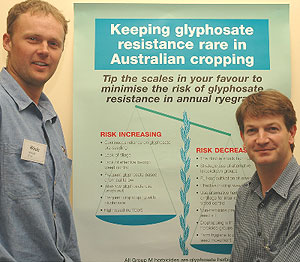Australia
April 4, 2006
by Peter Reading
The Crop Doctor
Grains Research and Development
Corporation (GRDC)
Do you use glyphosate? Well if you want to keep
using it you must use it responsibly, otherwise weeds will
become resistant.
|
 |
|
Rick Llewellyn (L) Chairman of the
Glyphosate Sustainability Working Group (GSWG) discusses
the options for lowering the risk of glyphosate
resistance with South Australian farmer Wade Nicholls |
That is the message from the national
Glyphosate
Sustainability Working Group (GSWG). Consisting of
researchers and industry representatives and with support from
CropLife Australia (formerly AVCARE) and the Australian Weed
Management CRC, the GSWG has the task of minimising the
development of glyphosate resistance and maximising the
effective life of this key herbicide.
Since 1974, when glyphosate was first introduced,
researchers have been searching for molecules with similar
properties. Every year, the major crop protection companies
involved in research and development each screen approximately
0.5 million compounds in the hope of identifying potential new
pesticides.
Based on the low number of products with unique
characteristics released in recent years, it can be deduced that
not many unique molecules or compounds with all the attributes
of crop safety, efficacy, environmental and human safety are
found. Of those found, not all are suited to Australian weeds
or our broadacre crop production.
Currently there is no glyphosate equivalent in
development, so growers must use glyphosate responsibly to
prevent the development of glyphosate resistant weeds,
especially annual ryegrass, on their property.
Responsible use includes diversifying the range
of herbicides applied as well as using physical rather than
chemical control methods to reduce weed seed banks.
The strategic use of alternative ‘knockdown’
herbicide groups, that are not Group M, effective in-crop weed
control, use of alternative herbicide groups or tillage for
inter-row or fallow weed control, crop topping using weed seed
catchers at harvest and using the ‘double knock’, are all
alternatives that can help lower the risk of herbicide
resistance.
The ‘double knock’ is an application of
glyphosate followed by application of a paraquat-based product.
This strategy relies on paraquat controlling rare glyphosate
resistant survivors. The glyphosate survivors are not often
controlled by low rates of paraquat, nor are large ryegrass
plants. so the ‘double knock’ strategy relies on applying both
herbicides at appropriate rates for the targeted ryegrass
plants.
Assisted by the Australian Weed Management CRC
the GSWG has developed a website (www.weeds.crc.org.au/glyphosate/)
containing useful information and resources about weed
management techniques to minimise the risk of glyphosate
resistance. There are answers to frequently asked questions,
fact sheets, information on identification and testing for
glyphosate resistance and a database of glyphosate resistant
weed populations. Growers and agronomists are encouraged to
visit the site and use and share the information as widely as
possible.
The Crop Doctor, Peter Reading, is managing
director of the Grains Research and Development Corporation
(GRDC), Canberra. |